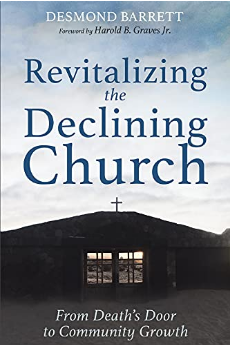Revitalizing the Declining Church: From Death’s Door to Community Growth, by Desmond Barrett, offers hope for declining churches that are willing to imagine new possibilities, dig their heels in, and let go of the past.
If you’re a church leader, I don’t need to share the statistics with you. You’ve either read them, felt them, or become them. According to Barna’s research, church attendance has dropped in every age category below levels seen in the last 20 years. Thousands of churches are closing every year. And, of course, most of the statistics we read are pre-COVID. The decline has only accelerated in the past year. Is the answer to simply give in, give up, and lock the doors?
Not So Fast
Desmond Barrett has assembled a short and encouraging book based on his experience and research of case studies of churches that have put in the work of revitalization to see new life and new hope in their communities. Revitalizing the Declining Church offers hope and a new vision to churches feeling the slide into those painful statistics.
Kyle Bueermann reminds us, “As the head, (Christ) alone has the power to bring back to life a church that’s on the brink of death. The good news is, of course, that He loves to bring things that were once dead, back to life.”
page 7
Advice and Experience
Revitalizing the Declining Church is not written with well-meaning but often hollow advice of the church growth expert crowd (I’m sorry, is my opinion showing here?); Barrett has been in the trenches. As he explains in his preface, he accepted a call to a rural Appalachian church on the verge of closure. He was able to motivate and mobilize the congregation to stability and growth. The book itself is a compilation of his doctoral dissertation, bringing hours of research and interviews with others who have put in the hard work and made the difficult choices that led to a turnaround in their churches.
Given that this is the result of his doctoral work, it’s interesting that the book weighs in at a mere 74 pages. I would expect something much more significant from academic research, but in the end, the length is just right. The audience for this book does not need to be overwhelmed or intimidated; we need solid help and encouragement. Everything in this book seems realistic and doable.
Hard Choices Ahead
There are no stories of outlandish success in Revitalizing the Declining Church. No church went from an attendance of a mere handful to being packed to the gills with multiple services. Nothing seems impossible or borderline miraculous, causing the reader to wonder, “where’s my miracle?”
You will find here some hard choices that had to be made by churches who valued the future of the Kingdom of Christ more than the legacy of their own pasts. Some churches dropped beloved programs that had defined them for decades, redefined who they were in the face of changing communities, and even turned the keys over to new churches and ministries better equipped to move forward. Be warned: nothing here is easy, and some of it even feels discouraging before you encounter new hope.
There is nothing easy about the call to be a turnaround pastor. The hours are long, the sacrifices can be painful, and the results can be minimal. For example, Shepherdsville, the first case study in the book, is still running an average attendance of under forty, yet its impact is in the hundreds. Barrett hits the reader with a hard dose of reality that will cause you to redefine what a win for your church might be.
The Priority of Prayer
Every expert you listen to and every book you read on church growth places the first emphasis on prayer. With Barrett, it doesn’t feel like it’s just lip service. He couples prayer with hard work and deepening vision. Prayer is transformative for the pastor, the congregation, and ultimately the community.
The revitalizing pastor would structure every activity and every service around a prayer component. Prayer would not just be a passing fad, or a ritual done as part of the service; prayer would be the heart of the church.
page 13
Read the Book – Stay for the Epilogue
I discussed Barrett’s book with a friend who recently completed his doctorate (in a bizarre display of one-upmanship, he told me his dissertation was only 60 pages long). He noted that most books could be reduced to just one chapter. Barrett’s epilogue could easily be a book on its own, or distilled into a conference presentation. Instead, he has loaded the epilogue advice and encouragement every pastor and church leader needs to hear.
While other chapters make mention of Covid-19, the epilogue hits with the reality of the challenges of the post-COVID church. Yet, rather than despair, Barrett finds new opportunities and hope for those who are willing to see possibilities in a “new normal.”
How many times have you heard or said to yourself; I wish things would return to normal. It is becoming more apparent that things will not return to normal for some time, and maybe that is a good thing.
page 72
You’re Doing Better Than You Realize
Spoiler Alert! The book ends with the words, “you’re doing better than you realize.” It is a needed reminder to everyone who puts in a hard week of church work only to lay in bed awake wondering why they’re going to do it all over again the following week. You need the confrontation, reality, hope, imagination, and encouragement this book offers.
Because you’re doing better than you realize.
Revitalizing the Declining Church would be an excellent read for a group of pastors. So take it chapter-by-chapter, bringing some thoughts and insights from your communities.
Each chapter ends with “Five Revitalization Rewards.” Of course, not all will apply to your situation, but seeing them with a group of others could help you adapt these rewards to your setting and open your eyes to new visions you haven’t yet considered.
This book would also be an excellent gift for the members of your church leadership. If your elders are like mine, they don’t handle large books very well (unless you go ahead and circle Waldo on each page for them). However, this book is not overwhelming. Assign a chapter a month, have one of your leaders function as a discussion leader, and see what kind of vision they might catch for your church’s future.
Trust me; your leaders also have those sleepless nights and need to know that they’re doing better than they realize. Revitalizing the Declining Church could help them dream about new possibilities.
Check out my notes and highlights from Revitalizing the Declining Church on Goodreads.

